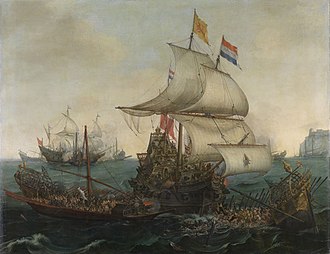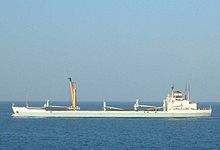Navy
![]()
The title of this article is ambiguous. For other meanings, see Marine (disambiguation).
The term navy is understood to mean the entirety of a state's fleet at sea. This consists of its merchant navy and its naval forces. The word navy is derived from the Latin word marinus, belonging to the sea.
In many states, the military ships of the navy can be distinguished from the civilian ships of the navy and those of the merchant navy by the flag flown. Warships fly a naval ensign ( ![]() ? ), civilian naval ships a service ensign (
? ), civilian naval ships a service ensign ( ![]() ? ), and merchant ships the merchant ensign (
? ), and merchant ships the merchant ensign ( ![]() ? ).
? ).

A warship sailing under state flag. At the stern the "blood flag" for the joint attack on the enemy, in the main stop the flag of the Staten Generaal and here also the mark of the admiral ship. In the fore- and mizantop the general flag of the United Provinces of the Netherlands.
Military
History
Originally, the navy was merely the land army embarked for overseas warfare operations. Increasing maritime trade necessitated the protection of merchant ships, initially by armed ship's crews, and later by warships (convoy ships). In addition, already in antiquity some states maintained permanent navies in order to be able to exercise their power both at sea and in foreign countries. The first organized navies were found among the Carthaginians, Greeks and Romans.
General
The naval forces of a state are also called the fleet in common parlance. They consist of the actual fleet, the associated supporting units and facilities on land, as well as their organization and administration.
The Navy may be equipped with warships, support ships, and other assigned assets such as naval aviators, marines, support and training assets.
Within military navies, a distinction is usually made organizationally between one or more fleets and supporting elements such as bases, schools, etc. The forces at sea, on land and in the air are subordinate to the fleet command. Large navies have several fleets, such as the U.S. Navy with its 2nd, 3rd, 4th, 5th, 6th, and 7th fleets, or the Russian Navy with its Pacific, Black Sea, North Sea, Baltic, and Caspian flotillas.
According to a 2014 listing by The National Interest, the U.S. Navy is the most powerful navy in the world, followed by the navies of the People's Republic of China, Russia, the United Kingdom, and Japan.
Tasks and functions
Mastering the sea is the main task of navies in war. Strong navies are designed to ensure that their country can use the sea lanes as transportation routes for goods and military forces. Inferior navies usually focus on denying the enemy this use, even if they cannot use the sea themselves for their own purposes. Typical of this type of naval conflict were the two World Wars, in which the Allies, superior at sea, needed the North Atlantic as a supply route, while the inferior Germans wanted to prevent this use with their submarines and auxiliary cruisers, without ever having the chance themselves to carry their own sea transports across the Atlantic. In this respect, naval wars are often wars of attrition; the naval battle is the exception, even if it has shaped the image of naval warfare in the general consciousness.
Navies develop naval power as a military effect not only in war, but already in peace and in crises or regional conflicts. For example, the protection of sea routes and maritime trade against piracy is a permanent task for most navies, even in peacetime. This also includes the elimination of dangers in the waters, such as those posed by sea mines. Many navies also have national policing responsibilities, for example in monitoring and enforcing marine environmental protection. In crises and regional conflicts, naval forces, unlike land forces, can move on the high seas without obstacles under international law. Their presence in a region underlines the claim to power of the respective nation.
Germany
→ Main article: German Navy
In Germany, the term navy refers to the part of the Bundeswehr that specializes in military tasks on or from the sea, as distinct from the army and the air force.
The ranks in the Navy usually have different designations than those of the Army or the Air Force. The military designations are partly based on those of the merchant navy.

Frigate Hamburg (F 220) of the German Navy

Seamen / sailors

Warships of different nations in parade formation
Civil
→ Main article: Merchant Marine
In addition to the word merchant fleet in common use today, the term merchant navy is also used for the totality of all merchant ships of a country and the associated administration. In Germany, Art. 27 of the Basic Law stipulates: "All German merchant ships form a uniform merchant fleet."

Merchant ship
Search within the encyclopedia